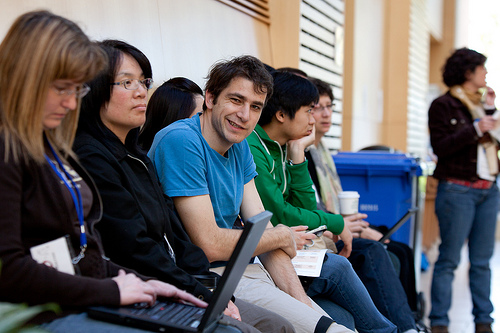How to Use Social Media for Events is a two-part blog series on best practices for event promotion and management using social media tools. Part 1 looked at tools such as WordPress, Eventbrite, Facebook and Twitter for organizing and promoting your event. Part 2 will look at ways to use social media tools, such as Foursquare, Facebook Places, UStream, Slideshare, Google Docs and Survey Monkey, during and after the event.
Social media tools are great for keeping attendees engaged at an event, capturing content from the event to use as promotional material and soliciting feedback from attendees afterwords.
During the Event
Use Foursquare or Facebook Places to check in.
A great way to engage attendees right off the bat is to encourage them to check in at the event via a location sharing app, such as Foursquare or Facebook Places. Consider offering a reward for checking in that can be picked up at the end of the event.
You could also encourage attendees to check in at different sessions. This will allow attendees to keep track of which sessions others are attending.
Build content by livestreaming, liveblogging or taking photos.
Part 1 noted that a good tactic to generate interest about your event is to post or tweet content from previous events. To ensure that there is content to use for promoting your next event, consider recording your event by livestreaming, liveblogging, or taking video or photos.
UStream is an effective tool for livestreaming your event, which is useful for people who couldn’t make the event. Another option for capturing your event as it happens is to have someone live blog the event.
Beyond livestreaming and live blogging, another tactic is to record video or take photos of the event. Video can be used to record sessions or to interview attendees in the halls in between sessions to record their takeaways from the day.
Use Twitter to keep in touch.
On the day of the event, encourage people to tweet using the event hashtag. Tweeting with the event hashtag allows attendees to follow tweets from sessions that they missed. Similar to livestreaming or live blogging, tweeting at the event using the event hashtag also lets those who couldn’t make the event follow along via Twitter.
It is also a good idea to encourage speakers and attendees to share their Twitter handles so that people can connect during the event and stay in touch afterwords. Consider using a whiteboard or flipchart to display speakers’ Twitter handles. Also encourage attendees to post their Twitter handles on the event wiki to capture a list of attendees others could follow.
Post Event
Use Google Docs or Survey Monkey to survey attendees.
Use Google Docs or Survey Monkey to send out a survey to attendees after the event in order to ask them how the day went. Survey feedback can be invaluable next time you organize an event and, if you get permission from those surveyed, the feedback from surveys can be useful content to post to the event blog or to use in your portfolio as quotes or reviews.
Upload content to YouTube, Facebook and Slideshare.
Content that was captured during the event, such as video and photos, should be uploaded to YouTube and Facebook. If presenters make their slides available on Slideshare, update the speakers’ bio page or session page with the slide presentation.
Content that’s uploaded should be posted to the event blog or wiki, tweeted about and sent out to attendees via email. A great way to get attendees to contribute is to ask them to visit the event Facebook page and tag themselves in the photos.
Say “Thank You”.
The most important thing you can do after an event is send out a thank you to speakers, attendees and sponsors. Thank them for their participation and for making the event a success.
Have a great event marketing tip? Share it in the comments.



